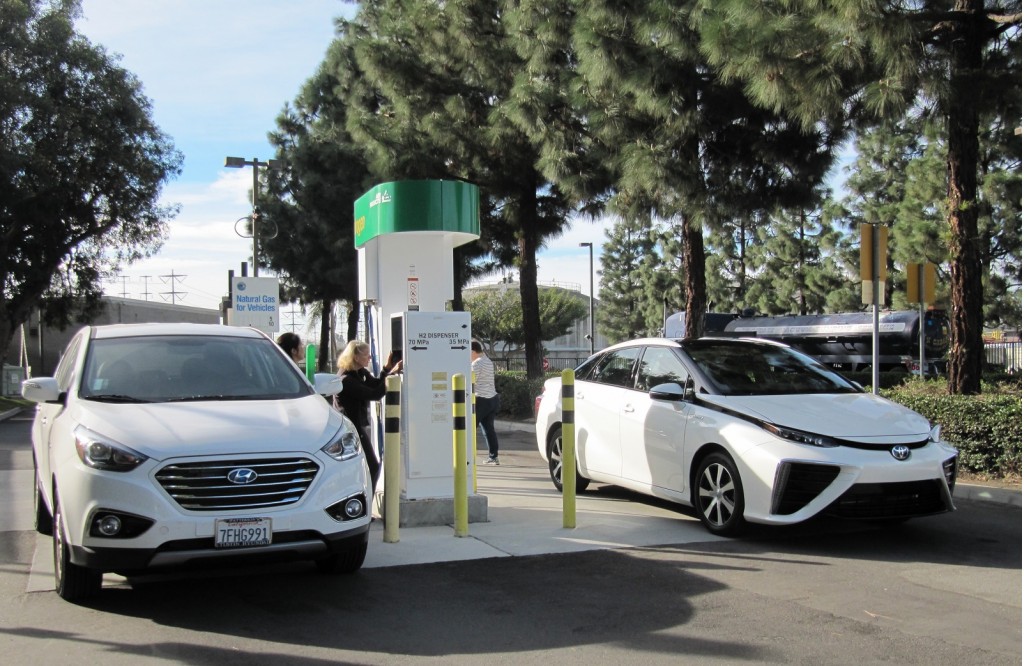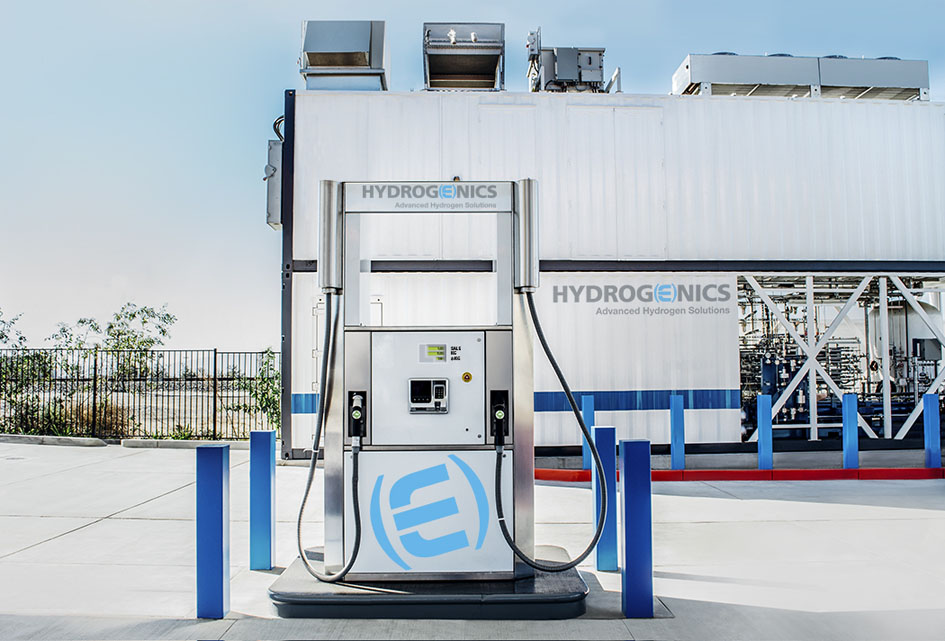
2015 Hyundai Tucson Fuel Cell, 2016 Toyota Mirai at hydrogen fueling station, Fountain Valley, CA
It's now clear that the zero-emission vehicles of the future will be powered by electric motors.
The electricity to power those motors, however, will come from one of two competing technologies: high-capacity batteries or hydrogen fuel cells.
The debate over which technology is superior, which has the lowest wells-to-wheels carbon footprint, and which is likely to appeal more to mass-market buyers has become ... epic.
DON'T MISS: 10 Questions On Hydrogen Fuel-Cell Cars To Ask Toyota, Honda & Hyundai (Oct 2014)
As long as the costs, efficiency, practicality, and consumer appeal of the two technology are publicly debated, Green Car Reports will publish a variety of articles exploring different ways to analyze those issues.
Our reader Victor A. Ettel, an electrochemical engineer and retired R&D executive, has had a life-long interest in advanced transportation technologies, including hydrogen fuel-cell vehicles.
He submitted an analysis comparing the energy usage of the two approaches that we felt was worthy of publication. What follows are his words, lightly edited by Green Car Reports for clarity and style.

2017 Honda Clarity Fuel Cell, Santa Barbara, CA, March 2017
Fuel-cell vehicles are, without a doubt, a brilliant technical accomplishment.
But with the technology rapidly maturing and approaching its limits, it is becoming clear that they cannot offer viable, cleaner and more sustainable transportation than other showroom-available, new vehicle technologies.
Emerging hard data leaves no room for any other conclusion, meaning that the life support for the fuel-cell dream increasingly depends on discredited assumptions, deceptive comparisons, and unconvincing distant future prognostications.
READ THIS: Is Toyota's hydrogen fuel-cell fervor foolish, or foresighted? (with charts)
The two most energy-efficient vehicles among the three fuel-cell cars now offered in California are the Honda Clarity Fuel Cell and the Toyota Mirai, rated at 68 and 67 MPGe respectively.
Miles Per Gallon Equivalent (MPGe) is the distance a car can travel electrically on the same amount of energy as contained in 1 gallon of gasoline.
But MPGe ratings should not be directly compared to the ratings of gasoline cars since, unlike gasoline, producing hydrogen requires twice the energy that the resulting hydrogen contains.

Hydrogenics hydrogen fueling station
Hydrogen wastes energy resources, whether fossil or renewable
This proves to be true whether the gas is produced by electrolyzing water or through steam reformation of natural gas.
This estimate, based on multi-year monitoring of existing hydrogen refueling stations, is consistent with design energy requirements published by a manufacturer of hydrogen refueling stations and other credible sources.
As both technologies have been practiced on an industrial scale for nearly a century, and their efficiency is limited by the laws of physics, these numbers cannot be expected to change dramatically.
CHECK OUT: All the challenges for hydrogen fuel-cell cars laid out
Moreover, as real fuel cells operate at around 50-percent efficiency, only a quarter of the initial energy (fossil or renewable) is available to power the fuel cell vehicle—compared to more than 80 percent of the initial electrical energy that remains available to power an electric vehicle.
As a result, the Honda Clarity Fuel Cell consumes more than three times more electricity per mile than an electric vehicle (e.g. the 2017 Chevrolet Bolt EV).
It also consumes almost the same amount of natural gas as the now-discontinued 2012 Honda Civic Natural Gas—which, unlike a hydrogen fuel-cell vehicle, did not use energy-conserving hybrid technology.
The idea that future transportation will be based on hydrogen produced from renewable electricity proves completely unrealistic, as it would require doubling total electricity generation in the U.S.

2015 Hyundai Tucson Fuel Cell, 2016 Toyota Mirai at hydrogen fueling station, Fountain Valley, CA
That would demand an increase in wind and solar-power generation by a whopping 1,500 percent, and the nation’s electricity distribution grid would require commensurate upgrades.
Considering three-quarters of the electrical energy stored as hydrogen is lost, proposals to use hydrogen to store intermittently produced wind or solar energy will likely prove unrealistic as well.
Whatever share renewable generation attains in the future electricity mix, wasting most of it by making hydrogen to power fuel-cell vehicles makes no sense whatsoever.
WHAT WE THOUGHT: 2017 Honda Clarity Fuel Cell: first drive of hydrogen-powered sedan
Fuel-cell vehicles produce more greenhouse-gas emissions
Because of their higher energy consumption, fuel-cell cars generate more greenhouse-gas emissions than other powertrain technologies.
The emissions come from the hydrogen-producing facilities that use natural gas, or from power-generating plants—but their effect on the environment is the same.
Greenhouse-gas generation estimates from hydrogen refueling stations in California show that a Clarity Fuel Cell, powered by hydrogen produced from natural gas or from the relatively low-carbon (or ‘clean’) California grid, produces 80 percent more greenhouse-gas emissions than a Toyota Prius or a Honda Accord Hybrid, a hybrid mid-size sedan of a similar size.
Most importantly, the Clarity generates more than three times the greenhouse-gas emissions of an electric car, such as the Chevrolet Volt plug-in hybrid, when running solely on battery power.
![Wells-to-wheels greenhouse-gas emissions from various vehicles [chart: Victor Ettel] Wells-to-wheels greenhouse-gas emissions from various vehicles [chart: Victor Ettel]](https://images.hgmsites.net/lrg/wells-to-wheels-greenhouse-gas-emissions-from-various-vehicles-chart-victor-ettel_100605684_l.jpg)
Wells-to-wheels greenhouse-gas emissions from various vehicles [chart: Victor Ettel]
The comparison chart above is based on official estimates of wells-to-wheels greenhouse-gas generation associated with using fossil fuels or with the generation of electrical power.
These numbers are again consistent with other credible studies, even though the obvious conclusions are left out.
To conclude that fuel-cell vehicles have lower total greenhouse-gas emissions than conventional cars, an otherwise excellent 2012 report estimates their emissions against an imaginary "conventional mid-size passenger car" with a fuel economy of 20 MPG (e.g., a Lincoln Continental).
ANOTHER EXAMPLE: Hyundai On Hydrogen Fuel-Cell Vehicles: Critiquing Its Claims (Feb 2014)
Publications aimed at the general public often propagate such disinformation.
As one official fuel-economy guide states, “[FCVs] generate much less GHGs than conventional gasoline and diesel vehicles.”
Very high fuel costs
Bob Carter, a senior Toyota vice president, has admitted that driving the company's Toyota Mirai sedan will not be cheap.
His estimate of $50 per 300 miles works out to twice that of driving a Prius, or four times the cost of driving an electric car. Carter based his comment on the U.S. Department of Energy’s projection of $10 per kilogram of hydrogen.
![2016 Toyota Mirai - Quick Drive - Portland, July 2015 [photo: Doug Berger] 2016 Toyota Mirai - Quick Drive - Portland, July 2015 [photo: Doug Berger]](https://images.hgmsites.net/lrg/2016-toyota-mirai_100521504_l.jpg)
2016 Toyota Mirai - Quick Drive - Portland, July 2015 [photo: Doug Berger]
But that number can be considered somewhat optimistic, as the energy requirement to produce compressed electrolytic hydrogen alone accounts for around $7 per kg.
Suggestions that the price of hydrogen can be brought down to, for example, $1.14 per kg appear outright dishonest.
To lease very limited numbers of fuel-cell vehicles each year, Honda, Hyundai, and Toyota all offer three-year leases that include $15,000 worth of "free" hydrogen fueling—clearly an unsustainable practice.
The approximate fueling cost estimates in the table below are based on five-year average retail prices of fossil fuels and of industrial-rate electricity.
![Approximate fueling costs in cents per mile for various vehicles [chart: Victor Ettel] Approximate fueling costs in cents per mile for various vehicles [chart: Victor Ettel]](https://images.hgmsites.net/lrg/approximate-fueling-costs-in-cents-per-mile-for-various-vehicles-chart-victor-ettel_100605681_l.jpg)
Approximate fueling costs in cents per mile for various vehicles [chart: Victor Ettel]
Another serious hurdle is that hydrogen fueling stations are expensive to install, and probably not viable without public financing.
Seven new stations in California, recently announced by Shell and Toyota, will cost $28 million. California will pay 60 percent of that total.
Operating around the clock, each station can fuel up to 300 hydrogen cars a day.
California expects to spend more than $200 million by 2024 to reach its target of 100 hydrogen stations, capable of supporting 30,000 fuel-cell vehicles—which is a mere 0.1 percent of all vehicles on California roads.
2015 Hyundai Tucson Fuel Cell, 2016 Toyota Mirai at hydrogen fueling station, Fountain Valley, CA
Unrealistic way to reduce oil use
Considering all the obstacles and requirements for new infrastructure (estimated to cost as much as $400 billion), fuel-cell vehicles seem likely to be a niche technology at best, with little impact on U.S. oil consumption.
Battery-based vehicles have a far more realistic potential to reduce oil consumption. The average daily driving distance of 30 miles is well within the range of new electric vehicles.
New plug-in-hybrids with battery ranges of 30 miles or more can eliminate most gasoline use on commuting trips, and operate as efficiently as hybrids on longer trips.
With the per-mile costs to fuel electric cars far lower than any other vehicle type, they have the potential to spread independent of government subsidies, as conventional hybrids mostly did.
In oil-rich Norway, a concerted long-term program of incentives and penalties has brought plug-in cars to 30 percent of all new vehicles sold today.
In the U.S., plug-in vehicles currently represent 1 percent of all new cars sold—but they already save more gasoline than do conventional hybrids, which have 2 percent of the market.
2016 Chevrolet Volt Vs. 2016 Toyota Prius
Tailpipe emissions and the zero-emission mandate
Advances in emission-control technology have reduced the tailpipe emissions of modern cars by more than an order of magnitude in 20 years.
So-called Super-Ultra-Low-Emission Vehicles, for example, are guaranteed to emit less than 0.02g NOx per mile, 20 times less than the average in 1994.
But 20 years ago, the regulators of the California Air Resources Board concluded that improving exhaust-gas treatment technology would not sufficiently reduce smog-forming and toxic emissions.
So they introduced a complex regulatory system that required carmakers to sell increasing percentages of zero-emission vehicles (ZEVs).
The original 1990 California ZEV mandate kick-started the development and commercialization of many new automotive technologies, including electric-vehicle batteries.
One unintended consequence of the mandate was the emergence of hybrid-electric vehicles, which have saved about 10 billion gallons of gasoline globally and reduced CO2 emissions by some 100 million tons.

Light-duty vehicle type scenario, now-2050 (California Air Resources Board)
The mandate was originally written to encourage all zero-emission powertrain technologies: not only battery-electric but also hydrogen fuel-cell vehicles.
Counterproductive?
Today, however, in my view, CARB's continued focus on developing fuel-cell technology has become counterproductive.
Carmakers produce them and subsidize their sales mainly to receive valuable ZEV credits for every one they deliver—credits that are higher than those they receive for other vehicles with lower wells-to-wheels carbon emissions.
As a senior Honda executive recently suggested, “California air quality targets could be met with new plug-in hybrids, if the regulators set air quality standards instead of mandating percentages of ZEVs … and let automakers figure out how to meet them.”
With available new technologies offering more energy-efficient, cleaner, and more economical alternatives than fuel-cell vehicles could possibly provide, even in a far-distant future, development efforts and heroic investments into hydrogen infrastructure no longer make any sense.
Green Car Reports welcomes commentary on the issues raised in this article, preferably with source citations. We respectfully remind readers that direct personal insults or profanity are not allowed under any circumstances, and ask that any such comments be flagged for moderation. Thank you in advance for helping us keep our comments on topic, civil, respectful, and fact-based.
_______________________________________













